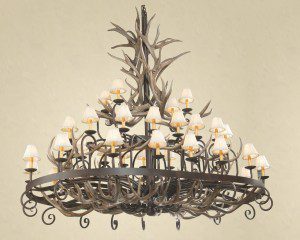If you’ve ever had chandelier lighting in your home, you know how beautiful the ambient light a chandelier casts can be. These light fixtures add a certain unique style to a room, whether they’re traditional crystal, modern glass, and stainless steel or made of deer or elk antlers. However, if you’ve ever had a chandelier, you also know that they tend to gather dust and can be very delicate to clean.
If you’ve purchased or are considering an antler chandelier for your home, you must know how to clean it properly. First, buying a faux antler chandelier will likely be made of acrylic, requiring special cleaning instructions. If it’s a natural, real antler chandelier, you’ll need to follow the proper steps for cleaning antlers. In this article, we’ll briefly overview the proper ways to clean faux and real antler chandeliers.
How to Clean Natural Antler Chandeliers?
It’s often recommended that you should clean natural antlers with hot water and bleach when you bring them home. These tutorials assume that you’ve just brought the antlers in from the woods, that the velvet is still attached to them, and that they must be treated before you mount them.
Fortunately, this has already been done for you. We do not recommend using hot water and bleach on your light fixtures, especially if they are painted. Instead, we recommend using distilled or white vinegar if they are painted. You can use almost any commercially sold surface cleaner, but we like this method better, as it’s gentler on the chandelier, the environment, and your wallet.
First, turn the chandelier off and find something else to do for about 30 minutes to an hour. You want to ensure that you don’t accidentally electrocute yourself when you clean your antler chandelier, and you want to ensure that the bulbs are all cool so that you don’t burn yourself.
Once the bulbs are sufficiently cool, get a stepladder out, and it’s time to start cleaning. Wipe any excess dust off the chandelier, including the bulbs, with a dry, soft rag. You might want to go over all the antlers at least twice to ensure you get rid of easily removed dirt and dust.
Next, mix your mild cleaning solution by pouring a cup of distilled or white vinegar into a quart of warm water. Dip a soft cloth into the solution, ring it out, and gently wipe down all surfaces. Go over the antlers with the damp rag, but avoid the bulbs and sockets. When finished, take a clean, dry, soft cloth, and wipe all excess moisture off the chandelier. Voila!
How to Clean Acrylic Antler Chandeliers?
While you can avoid using an all surface or window cleaner on unpainted, natural antlers, you can’t do this with acrylic. Acrylic breaks down when exposed to harsh chemical cleaners, so you’ll want to make sure that you use a mild soap or detergent solution. You can also use the same vinegar solution recommended on natural antler chandeliers.
After you’ve used your soap or detergent solution on an acrylic antler chandelier, you’ll want to ensure that you rinse all the surfaces you used soap on. Get some warm, clean water, and dip a soft rag in it. Wipe down the chandelier as you did with the soapy solution, then dry it off thoroughly.
For Other Kinds of Faux Antler Chandeliers and Painted Chandeliers
If your chandelier is made of a different material than acrylic, you should look up the specific cleaning instructions for that material. Some paints are sturdier than others, and some materials stand up to harsh cleaners better than others.
If you’re unsure what your antler chandelier is made of, contact the manufacturer and ask them. If you can’t find out what your chandelier is made of, don’t worry. You can use your vinegar and water solution on almost any material, though, as it is mild enough not to harm paint or any plastics.
While harsher chemical cleaners lift heavy layers of dust and dirt more easily if you make cleaning your antler chandelier a part of your monthly or bi-monthly cleaning routine, the dirt and dust won’t ever accumulate enough to be a problem.
A Word of Warning
You know that you want to avoid contact between electrical outlets and water. That includes the light bulb sockets in your chandelier. If you have any reason to believe that any water seeped into one of the sockets, don’t turn the chandelier back on until you’re absolutely sure that it’s dry and not a hazard.



